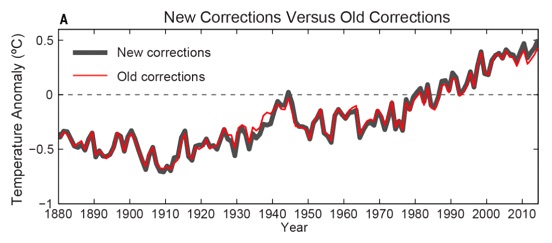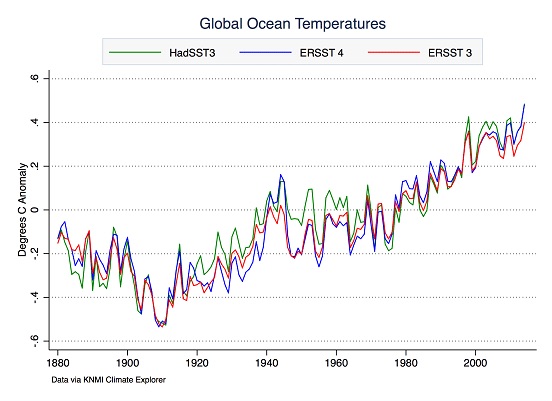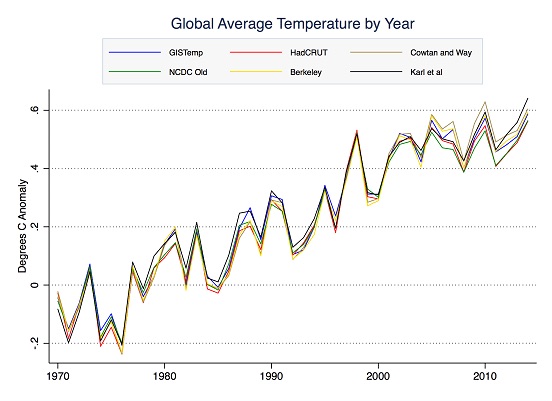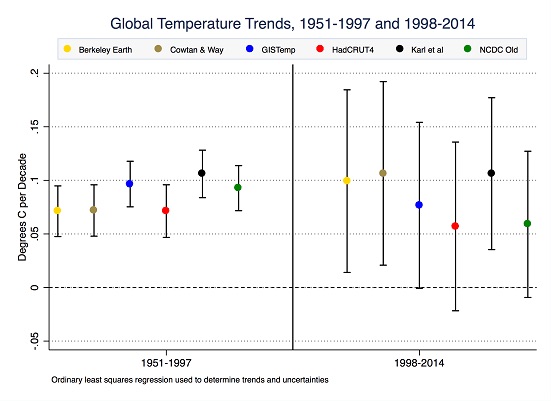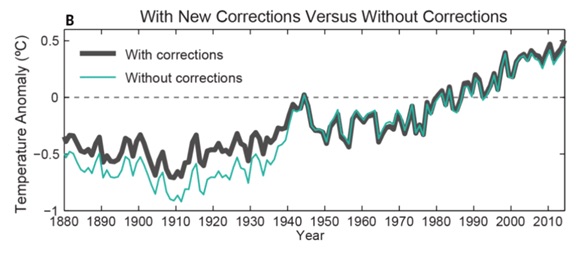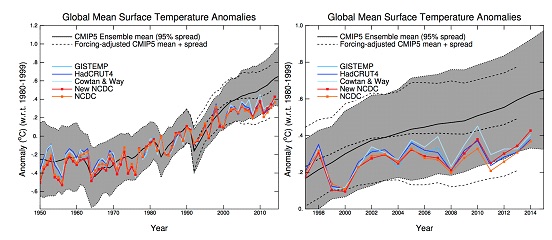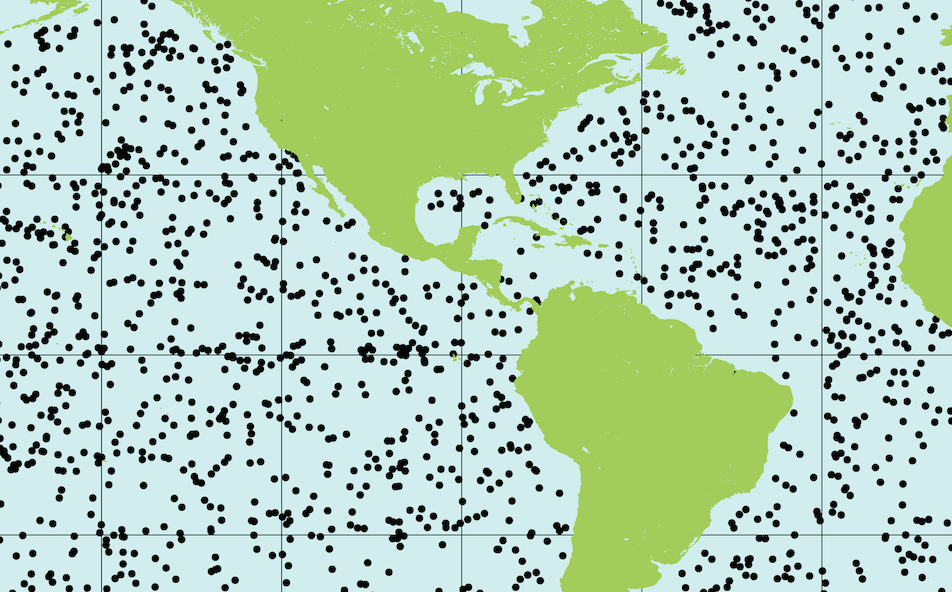
Some of the temperature-measuring floats in the Argo network, an international scientific collaboration, that were in place on June 8, 2015
By Zeke Hausfather
Yale Climate Connections
Mountains of ink have been spilled in recent years on whether or not global warming has paused or slowed down. We’ve discussed it at Yale Climate Connections extensively in the past, and numerous studies have examined whether the apparent pause might have been caused by additional ocean heat uptake, small volcanoes, a weak solar cycle, poor arctic coverage in existing datasets, and/or a whole host of other possible explanations.
A new high-profile paper just released in Science by Tom Karl and colleagues at NOAA argues that any slowdown in warming ended (if it ever really existed in the first place) as a result of two simple factors: correctly dealing with temperature readings from buoys, and the passage of time.
In a newly released estimate of global temperatures, they argue that the rate of warming over the past 17 years is no different than that for the prior 50 years, and that there is no apparent pause or slowdown in warming.
NOAA’s National Centers for Environmental Information (now housing what had been the National Climatic Data Center) has long produced one of the two official U.S. temperature records (the other is produced by NASA). The figure above shows the old record in red and the new record in black. Apart from a period prior to 1940 and after 2006 or so, the two are largely the same, and their long-term warming rates are quite similar.
In this new update, Karl and his co-authors made two major revisions to the previous approach. First, they updated their land record to include a much larger database of stations: around 32,000, compared with the 7,000 or so previously used. They did this by incorporating the databank produced in recent years by the International Surface Temperature Initiative, and running it through NOAA’s algorithm to detect and correct for instrument changes, station moves, time of observation changes, urban heat island effects, and other factors that could potentially introduce bias into the record.
The new land record is quite similar to the recent Berkeley Earth project in the data used and resulting temperature estimates, though the change from the old NOAA land record is relatively small and has little impact on the changes to the global record.
The second and far more important change the researchers made was to update the ocean temperature series used. NOAA previously had used a series called Extended Reconstructed Sea Surface Temperature (ERSST) version 3. The new release updates this to version 4, which introduces new corrections to the record. These account for the way ships measure temperature: whether they lower buckets into the water or measure water temperature through valves in the ship’s hull, which can make a significant difference in the resulting temperature estimates.
They also added a correction for temperatures measured by floating buoys vs. ships. A number of studies have found that buoys tend to measure temperatures that are about 0.12 degrees C (0.22 F) colder than is found by ships at the same time and same location. As the number of automated buoy instruments has dramatically expanded in the past two decades, failing to account for the fact that buoys read colder temperatures ended up adding a negative bias in the resulting ocean record. This change is by far the largest single factor responsible for changing global temperatures in the past 17 years compared to temperatures found in the prior NOAA record.
While NOAA uses the ERSST ocean temperature series, other groups like the Hadley Centre in the U.K. have their own record, HadSST version 3. They also make adjustments for buoys in recent years and changes in ship measurement practices, but end up with a somewhat different estimate than ERSST. The figure above shows the old ERSST 3, the new version 4, and HadSST side by side. ERSST 4 and HadSST differ noticeably between 1920 and 1970, but are rather similar before 1920 and between 1970 and the late 1990s.
Since 1998, during the period of reported slowing-down of warming, data from ERSST 3 was noticeably lower than from HadSST. The new ERSST 4 increases temperatures after 2006 to be the same as HadSST, mostly because of the new buoy corrections, but is still lower between 1998 and 2006. This difference explains why global temperature records based on HadSST tend to show flatter temperatures over the past 17 years, while the new NOAA record shows a more rapid trend. Over the longer term, the two show quite similar trends, but those small differences can be blown somewhat out of proportion when looking at short-term trends.
The new NOAA record really isn’t much different from that of other groups, as shown in the figure above. All have shown substantial warming since 1970, and even the differences after 1998 are relatively small. In all cases, the warming seen isn’t inconsistent with the prior warming trend, even if the short-term trends vary a bit.
Consider a direct comparison of the trends between 1951 and 1997 and those between 1998 and 2014 during the “pause” period. This approach is quite similar to that taken by Karl and his colleagues in Figure 1 from their paper, but applied to all the major groups estimating global temperatures. While the new NOAA series (Karl et al) is warming noticeably faster in the recent period than it had in the old NOAA series or in the Hadley record, it is actually warming less rapidly than in the Cowtan and Way series and at about the same rate as in the Berkeley Earth series, each of which have shown little or no pause.
All of which raises the second main reason to conclude that the “pause,” such as it was, is over: the passage of time.
Back when IPCC discussed the issue, data were available only though 2012. The last two years since then have been quite warm, with 2014 the warmest year on record in most series. With 2015 shaping up at this point to likely be a warm El Niño year and one potentially setting a new global temperature record, even series like Hadley’s HadCRUT will soon show little pause.
Some of the early critics of the new Karl et al paper are contending that adjustments for buoys, ship measurement types, station moves, and the like in effect amount to manipulating the record, creating more warming than would otherwise occur. However, as Karl and his colleagues point out, the net effect of their adjustments is actually to reduce the amount of warming over the past century, as shown in the figure above from their paper. There are slightly higher temperatures after 1998 as a result of their adjustments, but much smaller than the changes prior to 1940.
As one of the authors of the paper, Russel Vose, mentioned to the New York Times in its report on the new NOAA study, “If you just wanted to release to the American public our uncorrected data set, it would say that the world has warmed up about 2.071 degrees Fahrenheit since 1880. Our corrected data set says things have warmed up about 1.65 degrees Fahrenheit. Our corrections lower the rate of warming on a global scale.”
Despite the absence of a pause in recent data, temperatures are still on the low end of climate model predictions during recent years. However, Gavin Schmidt at NASA’s Goddard Institute for Space Studies argues that this is the case primarily because models do not properly account for recent changes in volcanic emissions, solar forcing, and man-made aerosols. When models take those factors into into account, Schmidt argues that this “places the observations well within the modified envelope” regardless of which temperature record is used.
No one, of course, expects the new NOAA report will end the debate on the warming slow-down (pause, “hiatus” or whatever terminology suits one’s preferences). Among those indelibly doubtful of the underlying climate science, this latest report assuredly will provide just more fuel for their fires. And among the “consensus” scientific community, the strengths and weaknesses, significance and limitations are certain to be grist for ongoing analyses and interpretation in professional peer-reviewed journals and at upcoming professional conferences.
Time will tell whether Schmidt’s own forecast – “So while not as dead as the proverbial parrot, the search for dramatic explanations of some anomalous lack of warming is mostly over” – ends up being prescient.
+++++
Yale Climate Connections, an initiative of the Yale Center for Environmental Communication, is a nonpartisan, multimedia service providing daily broadcast radio programming and original web-based reporting, commentary, and analysis on the issue of climate change. This article was republished with permission under a Creative Commons license. The first paragraph was revised to make clear that the original version’s reference to “this site” meant Yale Climate Connections. “NASA GISS” in the original was changed for clarity to “NASA Goddard Institute for Space Studies.”

